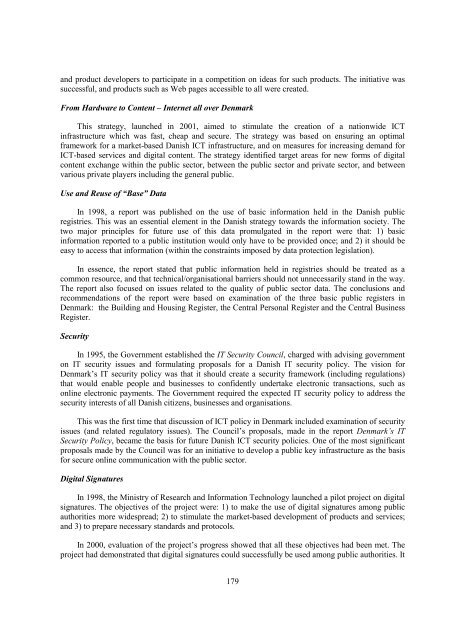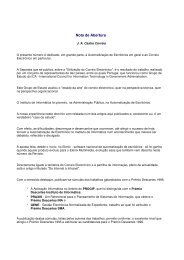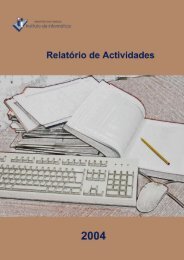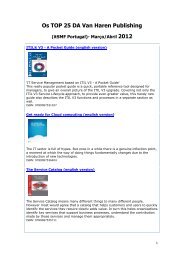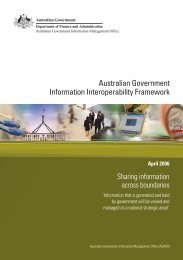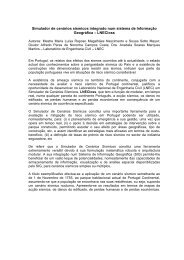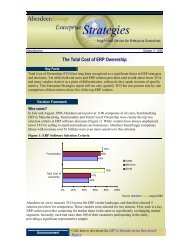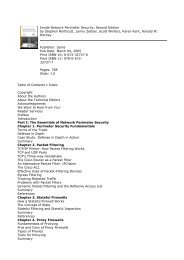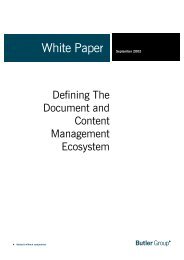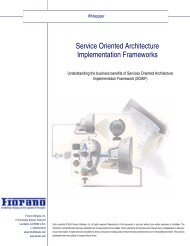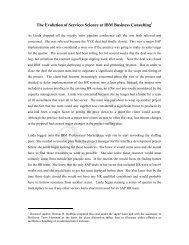OECD Peer Review of E-Government in Denmark - ePractice.eu
OECD Peer Review of E-Government in Denmark - ePractice.eu
OECD Peer Review of E-Government in Denmark - ePractice.eu
You also want an ePaper? Increase the reach of your titles
YUMPU automatically turns print PDFs into web optimized ePapers that Google loves.
and product developers to participate <strong>in</strong> a competition on ideas for such products. The <strong>in</strong>itiative was<br />
successful, and products such as Web pages accessible to all were created.<br />
From Hardware to Content – Internet all over <strong>Denmark</strong><br />
This strategy, launched <strong>in</strong> 2001, aimed to stimulate the creation <strong>of</strong> a nationwide ICT<br />
<strong>in</strong>frastructure which was fast, cheap and secure. The strategy was based on ensur<strong>in</strong>g an optimal<br />
framework for a market-based Danish ICT <strong>in</strong>frastructure, and on measures for <strong>in</strong>creas<strong>in</strong>g demand for<br />
ICT-based services and digital content. The strategy identified target areas for new forms <strong>of</strong> digital<br />
content exchange with<strong>in</strong> the public sector, between the public sector and private sector, and between<br />
various private players <strong>in</strong>clud<strong>in</strong>g the general public.<br />
Use and R<strong>eu</strong>se <strong>of</strong> “Base” Data<br />
In 1998, a report was published on the use <strong>of</strong> basic <strong>in</strong>formation held <strong>in</strong> the Danish public<br />
registries. This was an essential element <strong>in</strong> the Danish strategy towards the <strong>in</strong>formation society. The<br />
two major pr<strong>in</strong>ciples for future use <strong>of</strong> this data promulgated <strong>in</strong> the report were that: 1) basic<br />
<strong>in</strong>formation reported to a public <strong>in</strong>stitution would only have to be provided once; and 2) it should be<br />
easy to access that <strong>in</strong>formation (with<strong>in</strong> the constra<strong>in</strong>ts imposed by data protection legislation).<br />
In essence, the report stated that public <strong>in</strong>formation held <strong>in</strong> registries should be treated as a<br />
common resource, and that technical/organisational barriers should not unnecessarily stand <strong>in</strong> the way.<br />
The report also focused on issues related to the quality <strong>of</strong> public sector data. The conclusions and<br />
recommendations <strong>of</strong> the report were based on exam<strong>in</strong>ation <strong>of</strong> the three basic public registers <strong>in</strong><br />
<strong>Denmark</strong>: the Build<strong>in</strong>g and Hous<strong>in</strong>g Register, the Central Personal Register and the Central Bus<strong>in</strong>ess<br />
Register.<br />
Security<br />
In 1995, the <strong>Government</strong> established the IT Security Council, charged with advis<strong>in</strong>g government<br />
on IT security issues and formulat<strong>in</strong>g proposals for a Danish IT security policy. The vision for<br />
<strong>Denmark</strong>’s IT security policy was that it should create a security framework (<strong>in</strong>clud<strong>in</strong>g regulations)<br />
that would enable people and bus<strong>in</strong>esses to confidently undertake electronic transactions, such as<br />
onl<strong>in</strong>e electronic payments. The <strong>Government</strong> required the expected IT security policy to address the<br />
security <strong>in</strong>terests <strong>of</strong> all Danish citizens, bus<strong>in</strong>esses and organisations.<br />
This was the first time that discussion <strong>of</strong> ICT policy <strong>in</strong> <strong>Denmark</strong> <strong>in</strong>cluded exam<strong>in</strong>ation <strong>of</strong> security<br />
issues (and related regulatory issues). The Council’s proposals, made <strong>in</strong> the report <strong>Denmark</strong>’s IT<br />
Security Policy, became the basis for future Danish ICT security policies. One <strong>of</strong> the most significant<br />
proposals made by the Council was for an <strong>in</strong>itiative to develop a public key <strong>in</strong>frastructure as the basis<br />
for secure onl<strong>in</strong>e communication with the public sector.<br />
Digital Signatures<br />
In 1998, the M<strong>in</strong>istry <strong>of</strong> Research and Information Technology launched a pilot project on digital<br />
signatures. The objectives <strong>of</strong> the project were: 1) to make the use <strong>of</strong> digital signatures among public<br />
authorities more widespread; 2) to stimulate the market-based development <strong>of</strong> products and services;<br />
and 3) to prepare necessary standards and protocols.<br />
In 2000, evaluation <strong>of</strong> the project’s progress showed that all these objectives had been met. The<br />
project had demonstrated that digital signatures could successfully be used among public authorities. It<br />
179


